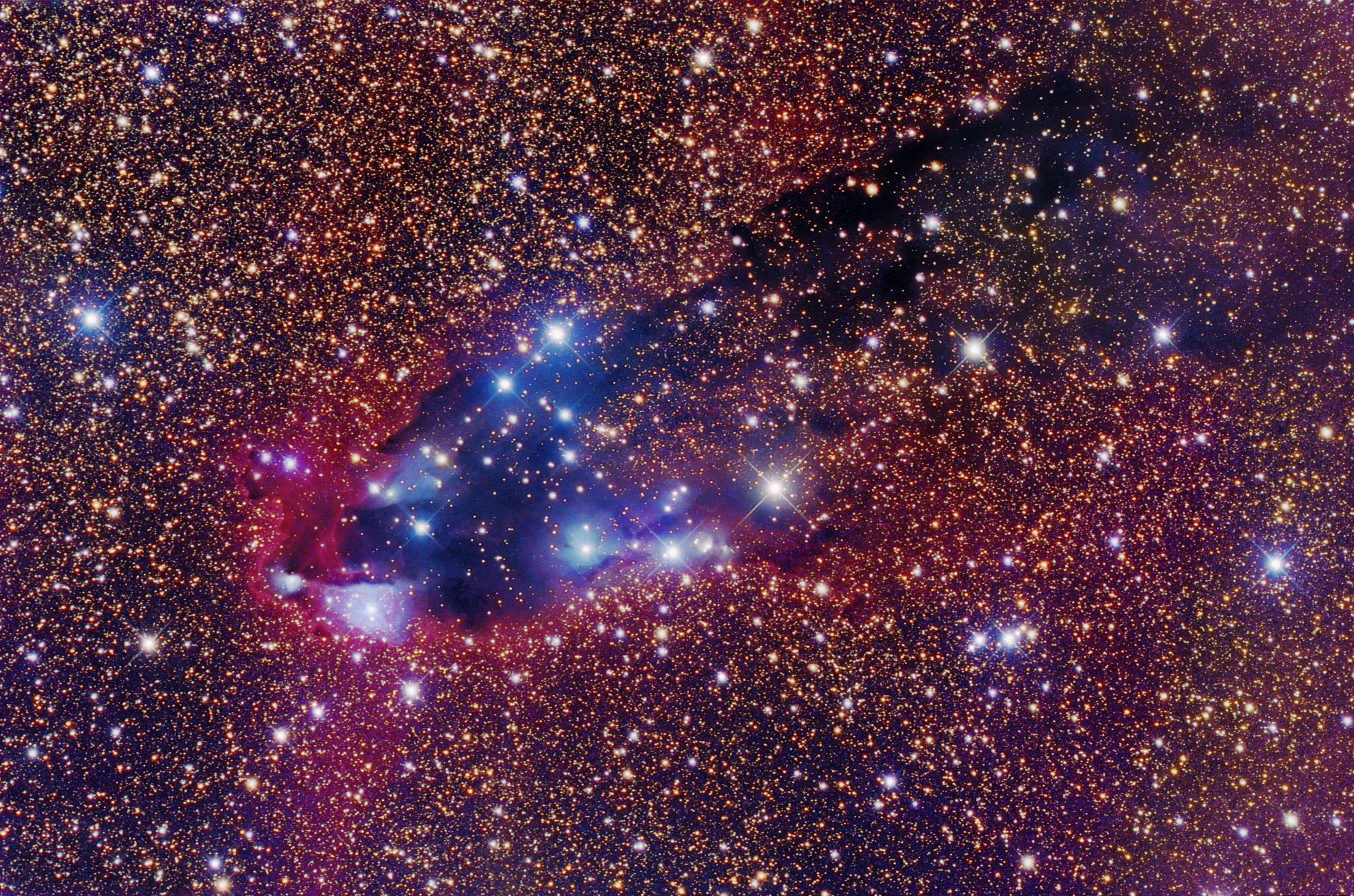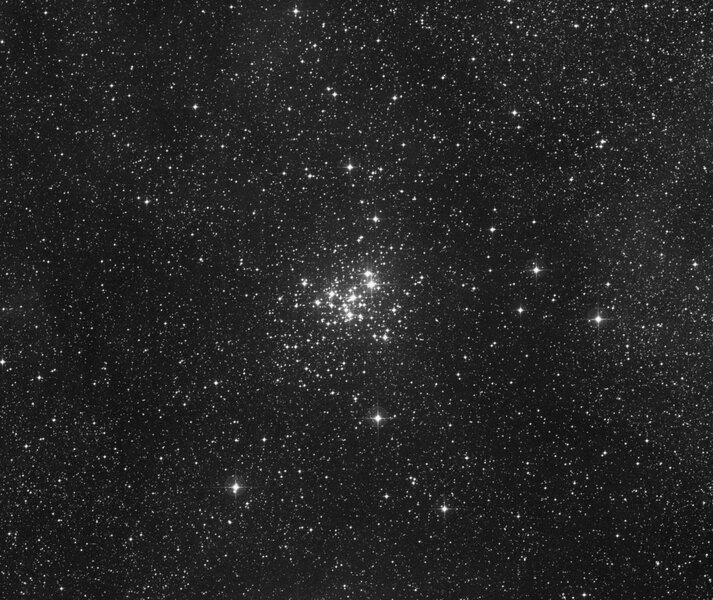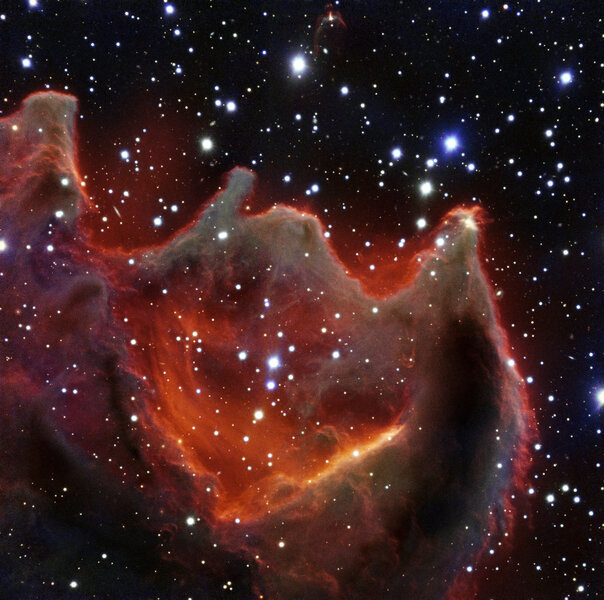Create a free profile to get unlimited access to exclusive videos, sweepstakes, and more!
Radiation driven implosion!

Ok, look, right off the bat: The title of this piece is only a part of what I’m writing about today, and a secondary part anyway. But come on. If you get the chance to type out the words “radiation driven implosion” then you take it.
I'll admit the exclamation point may be superfluous.
The question, though, is what’s imploding, and what’s producing the radiation that’s making it driven?
Well, let me introduce you to a type of astronomical object called a cometary globule. They’re not actually comets — they’re a type of dark nebula — but they look like comets, and pretty much for the same reason comets look like comets.
First, let me show you a cometary globule, a magnificent example called GN 16.43.7.01 (for its listing in the Atlas of Galactic Nebula catalog and its coordinates), but more colloquially as the Dark Tower:
Pretty cool, yeah? This image was constructed by Robert Gendler, using remote observations from a 37-cm telescope in Australia. It’s what’s called an LRGB image, with exposures taken using red, green, and blue filters for color information and one without a filter (called the luminance image) to see faint objects. It was a total of 12 hours of exposure, so it’s deep.
What you’re seeing is a dense cloud of gas and dust, so dense it’s actually opaque. It’s located in the constellation of Scorpius, which is toward the center of our galaxy. This is like looking downtown in a big city where there’s a lot more stuff going on. You can see thousands of stars in this image, but obviously many fewer where the cloud is darkest; it’s blocking the light from stars behind it.
You can also see that many of the stars around it are red — well, they look red. This is where the dust is thinner, allowing light from stars behind it to shine through. But they pay a price; dust grains in space scatter away bluer light, letting redder light to pass through. Astronomers — clever lot that we are — call this reddening.
Normally, this globule would just be kinda sitting out there in space, dense and cold and minding its own business. But not far away, outside the frame but to the lower left, sits a cluster of stars called NGC 6231. This clutch of stars contains some extremely luminous members, including Zeta Scorpii, which is an O-type star, massive and hot and blue. The cluster also has three ridiculously powerful Wolf-Rayet stars, too.
These bright stars flood nearby space with ultraviolet light, irradiating everything around them… including the Dark Tower. This pounds the cloud, causing the surface to heat up (that’s the red glow around it; hydrogen atoms excited by UV emit red light called H-alpha). It also erodes away the cloud, causing all those sandbar-like features pointing directly at the cluster. The gas eroded off gets blown “downstream” from the cluster, too, creating the long comet-like tail. That’s why this is a cometary globule!
A wider view of the Dark Tower shows this even more clearly. We see a lot of these where material strewn between the stars is thick.
Another lovely one is called CG4:
In this one (taken using the Very Large Telescope), you can see the same overall features as in the head of the Dark Tower, but in greater detail (there’s a reason it’s called the Very Large Telescope). You can see the finger-like sandbars, the photoevaporated material, and more delicate streamers and knots carved out by the complex processes going on around the globule. Unlike the Dark Tower, it’s not clear what’s creating CG4’s comet shape. There’s no bright cluster nearby, though the tail does seem to point away from the Vela Supernova remnant nearby; it’s possible the material blown out from the exploded star affected the globule.
But if there is a cluster or very luminous star near a cometary globule, the starlight can be so intense that the pressure from the light will actually compress the material in the cloud. If it compresses enough, stars can form from the material there. So radiation from the stars drives an implosion in the cloud: radiation driven implosion! Aha!
Radiation driven implosion. Yup. I like writing that.
Despite the colossal energies and violence involved, this is actually a delicate dance. Not enough radiation won’t do anything, and too much can evaporate the cloud entirely. You need just the right amount to drive collapse… and even if it’s in that range, more radiation tends to make fewer stars, and those will have lower mass overall.
Making stars is pretty hard. It’s kind of amazing we have so many of them.
And we do, as well as a menagerie of other types of objects out there to discover, explore, and understand. That’s one of the reasons astronomy is so much fun!
Also, you get to say stuff like “radiation driven implosion.” That’s pretty fun, too.
[My thanks to Robert Gendler for helping me track down the catalog number for this object.]





























